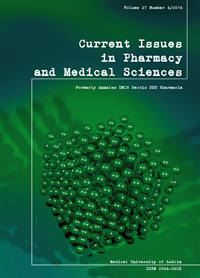Impact of the grasping test on women’s cardiovascular systems, and the possibility of replacing the orthostatic tolerance test with it
DOI:
https://doi.org/10.1515/cipms-2015-0018Keywords:
hypokinesia, orthostatic intolerance, Orthostatic Tolerance Test, Grasping TestAbstract
The aim of this study was to test the impact of the Grasping Test (GT) on the female cardiovascular system and to ascertain the possibility of using this to replace the Orthostatic Tolerance Test (OT). In this study, 15 volunteer female students were examined, and their physiological parameters - their systolic (SBP) and diastolic blood pressures (DBP), and their heart rates (HR) - were compared. We found that the Orthostatic Tolerance Test (changing the position of the body from recumbent to upright) and the Grasping Test induced meaningful but similar changes in the functioning of the women’s cardiovascular system. The results confirm that there were significant similarities between the cardiovascular system measurements as produced through the Orthostatic Tolerance Test and the Grasping Test. The possibility of introducing the procedure into clinical practice is a crucial factor for continuing our research in the wider population.
References
1. Bacir B. et al.: Omdlenia jako problem kardiologiczny. Przegląd Lekarski, 509-513, 53(6), 1996.
2. Bou-Holaigah I. et al.: The relationship between neurally mediated hypotension and the chronic fatigue syndrome. JAMA, 961, 274, 1995.
3. Calkins H., Rowe PC: Relationship Between Chronic Fatigue Syndrome and Neurally Mediated Hypotension. Cardiol. Rev., 125-134, 6, 1998.
4. Celej-Szuster J. et al.: Osteoporosis – risk factors, prophylaxis, diagnostic tests and pharmacotherapy. Current Issues in Pharmacy and Medical Sciences, 105-108, 26(1), 2013.
5. EI-Bedawi KM., Hainsworth R.: Combined head-up tilt and lower body suction: A test of orthostatic tolerance. Clinical Autonomic Research, 41-47, 4, 1994.
6. Golec L.: Hipograwia ortostatyczna. Polski Przegląd Medycyny Lotniczej, 41-47, 7, 2001.
7. Ismena Głowania: Hipotonia ortostatyczna u pacjentów w podeszłym wieku. Medycyna metaboliczna, 78-84, 4, 2000.
8. Koźluk E., et al.: Indukowany pionizacją częstoskurcz zatokowy -spojrzenie na czynnościowe zaburzenia rytmu. Kardiol. Dypl., 32-36, 8(1), 2009.
9. Lelonek Małgorzata: Nagła utrata świadomości- praktyczny przodownik. Terapia, 6-11, 19(3), 2011.
10. Low PA et al.: Postural tachycardia syndrome (POTS). Neurology, 19-25, 45, 1995.
11. Masuo K., et al.: Changes in freguency of orthostatic hypotensjon in elderly hypertensive patients under medications. Am. J. Hypertens., 263-268, 9, 1996.
12. Mellingsæter MR et al.: Gender differences in orthostatic tolerance in the elderly. Aging. Clin. Exp. Res., 659-65, 25(6), 2013.
13. Reznik et al.: Mortality from miocardil infarctio in different types of hospitals. Br. Med. J., 1121-1125, 294, 1987.
14. Rumuński S.: Częstość występowania i wyniki leczenia hipotonii ortostatycznej. Praca doktorska.
15. Schondorf R., Freeman R.: The importance of orthostatic intolerance in the chronic fatigue syndrome. Am. J. Med. Sci., 117-23, 317, 1999.
16. Stewart JM et al.: Patterns of orthostatic intolerance: the orthostatic tachycardia syndrome and adolescent chronic fatigue. J. Pediatr., 218-25, 135, 1999.
17. Stewart JM.: Common syndromes of orthostatic intolerance. Pediatrics., 968-980, 131(5), 2013.
18. Sviridkina NB et al.: Morphofunctional study of antiortostatic hipokinesia action in the case of focal ischemic brain cortex damage. Patol. Fiziol. Eksp. Ter., 22-6, 2, 2012.
Downloads
Published
Issue
Section
License
Copyright (c) 2015 Authors

This work is licensed under a Creative Commons Attribution-NonCommercial-NoDerivatives 3.0 Unported License.


